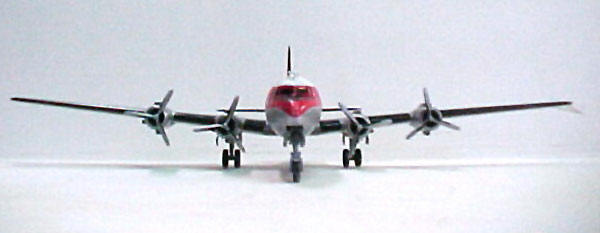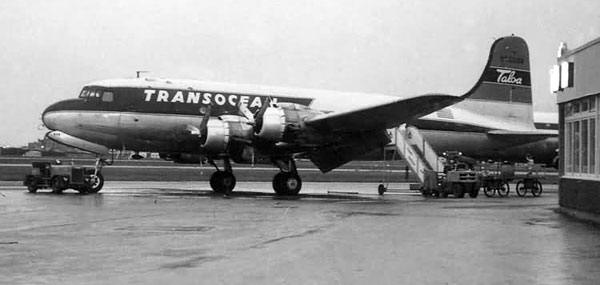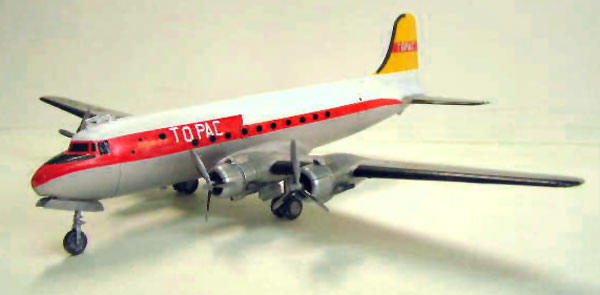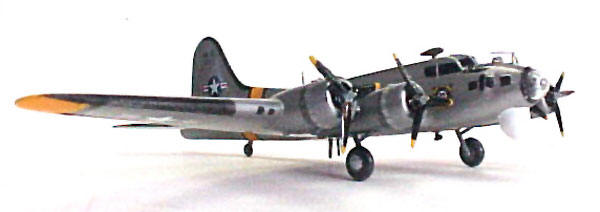|
Propliner Golden Age - When Round
Engines Ruled the World: Aircraft of “The High and the Mighty”
The Douglas DC-4 &
the Boeing PB-1G
in 1/144 scale
by Joe Lyons


HyperScale is proudly supported by Squadron
Flight 420,
rolling towards its Great Adventure…
“Wing flaps?”...…”15 degrees”
“Mixture?”………”Auto rich”
“V1 and V2 speeds?”….”112 and 116 miles per hour. That about does it”
“You want to check the radios, Dan?
”Right…420 ready for take off”
“Ok, Lennie, let’s deliver your tray”
[From the screenplay]
“The High and the Mighty”
The aviation movie “The High and the Mighty” was released
in 1954 and recently reissued in DVD format after extensive restoration of the
original print. I saw it first-release after just attained two digits in age
and, was entranced by the whole experience. My modeling experience of the time
was limited to Strombecker, Aurora and Lindberg, but it was a good beginning.
Later I was to discover the writings of Ernest K. Gann, author of the screenplay
and the book from which it was derived.
The Movie
In this and other movies and books Gann folded in his
experience as an airline pilot to craft perhaps the finest examples of their
kind. “The High and the Mighty” in addition to being an excellent
depiction of commercial aviation in the early ‘50s is now considered to be the
first of the “disaster” movies.
It was while Gann was working at Transocean
that he wrote his novel “The High and the Mighty.” Inspired by several
incidents that had occurred during the airline’s trans-Pacific operation, the
storyline evolved into the tale of a routine airline flight suddenly and
terrifyingly stricken with what appears to be a potentially catastrophic
situation – a runaway prop and engine fire occurring at night halfway between
Hawaii and the mainland.
The actual flying scenes were filmed during the third
week in November 1953 using a Douglas DC-4 borrowed from Transocean and piloted
by Keating. The DC-4 was painted in the fictitious airline colors of the
Trans-Orient Pacific Airlines …and filming was done at both San Francisco
and Oakland airports, with some ground scenes shot at Burbank. The ending scene
showing all the passengers and crew deplaning in San Francisco according to the
pilot was actually filmed at the old and now-defunct Glendale Air Terminal east
of Burbank, California, where a special outdoor movie set was constructed to
replicate the terminal gates at SFO in those days.
[Shane, in Airpower]
Actor Robert Stack who played Sullivan, Captain of
Trans-Orient Pacific Airlines (“Topac”) flight 420 parodied his
deadpan acting in this film in the later hilarious “disaster” movie send-up,
“Airplane.” Director William Wellman and writer Gann were experienced
aviators, a combination that ensured accuracy in the aviating portions of the
film.
The Airline
The DC-4 “stars” of the movie are marked with the acronym
of a fictitious airline, TOPAC but they are painted in the colors of
Transocean Airlines, which loaned two of this type for the movie production.
One of them, N4726V, is replicated for this article. Transocean
was based in Oakland CA and did business from 1946-1962 back when round engines
ruled the skies. It was basically a non-sked, but had interesting arrangements
with first tier airlines from time to time.

Figure
SEQ Figure \* ARABIC
1
Transocean DC-4. Ron Dupas: by permission
Transocean eventually folded in 1962 (an interesting
story in itself), but its founder Orvis M. Nelson started another firm, Air
Systems, based in Cophenhagen that used surplus Douglas C-74 Globemasters
to ferry cattle and racehorses throughout Europe.
But on the other hand, I like flying, and it would be
interesting to see the reaction of the animals….We took the train to Gatwick,
and I had my first view of our aircraft standing a few hundred yards away out on
the airfield. It looked very smart, its red, white and silver-grey paint
glittering in the sunshine. “Gosh, it’s big!” I said. Mr. Costain nodded. “Yes,
it’s a Globemaster, and to the best of my knowledge it is the biggest
aircraft in the world at the present time.” I don’t know whether he was right
about this but it was easy to believe…
[James
Herriot, “The Lord God Made Them All”]
Four identifiable airplanes can be found in “The High and
The Mighty.” The DC-4 of course is the “star,” accompanied by its faithful
escort and partner, the United States Coast Guard PB-1G. Also seen are a C-46,
and later a brief glimpse of a Coast Guard PBM. The first two, with more “film
time” as it were, are presented in this article.
DC-4
After an abortive and overweight start the DC-4 was poised
to take commercial aviation to a new plateau in 1941. Its design, Douglas or
airline funded, was complete and a good engine had been found. The war
intervened, and the rest is history. During the war the C-54/DC-4 made routine
flight across oceans by landplanes. The fourth Douglas Commercial launched
Douglas on its post-war dominance of the large Propliner market.
There were so many cheap surplus C-54s around in 1945 that
Douglas could only sell a few new copies of the design modified specifically for
commercial use. Transocean had almost 70 of various surplus models on
strength from time to time during its existence.
The Douglas DC-4 was still in widespread use by major
airlines in the ‘50s but soon would be eclipsed by the pressurized Lockheed
Constellation and its Douglas successor, the DC-6.
N4726V This airplane had the usual diverse
service of most of the war-built propliners. Before its time with Transocean
during the years 1953-55, it had been the personal aircraft of Juan Peron and
was operated by Slick Airways. Subsequently it was leased to probably a
number of operators by Airwork and later operated by World Airways.
It was to have at least one more operator. While with Transocean it was
known as “The Argentine Queen.”
PB-1G
The USCG Flying Fortress plays a supporting role in the
movie, but a fascinating one nonetheless. Clearly the Coast Guard took advantage
of an opportunity to show case its SAR credentials, with additional appearances
of a water-borne PBM and a crash boat complete with siren. We see a state-of-the
art use of the “interceptor” B-17 first to locate, and then fly shotgun on the
crippled airliner as it strives to make the coast.

Figure
SEQ Figure \* ARABIC
2
PB-1G #77255. USCG Photo
Although we know a lot about the DC-4 used in the film,
nothing is known about the PB-1G other than one is in the film, possibly via the
use of stock footage. This in spite of the fact that the Coast Guard never
operated more than 16 of the type, all but one starting life as a B-17G-VE-110
in 1945. All the USCG Forts got to that service via the USN as part its
acquisition of B-17s for its land based airborne early warning program. I have
chosen to replicate BuNo 77255 because its photo is in the public domain and it
was assigned to CGAS San Francisco in 1952, the base that launched N4726V’s
interceptor. It would accumulate 4720 flight hours before being declared surplus
and sold in 1958. In the film and book, the “interceptor” is always referred to
as the “Coast Guard B-17.” Probably few readers in 1953 had ever heard of a
“PB-1G” but many could be counted on to recognize “B-17.”
The Fort’s use as a SAR aircraft was developed by the USAAF,
itself following the RAF’s lead in using large droppable life boats to support
downed bomber crews a long way from home. Although there are photos of USCG
PB-1Gs carrying these boats, they were apparently never used even in training,
few PB-1Gs carrying them after the late 1940s. The other major visual
modification to USCG Forts was in the installation of an SCR-717B radar in the
chin turret position. There was evidently a problem with this radar, at least in
Gann’s opinion (and perhaps that of the Coast Guard advisor to the film):
The radar equipment on the interception ship, however, was notably
inadequate, and the chances for a successful meeting of the two ships would be
greatly increased if the crews could visually observe each other’s lights or
pyrotechnics.
[“The High
and the Mighty”, p189]
“Can you climb any higher? This stuff is not supposed to be very high and if
we could get on top, interception would be much easier.”
“Negative. We can climb, but don’t want to use the fuel. Every gallon is a
mile nearer the shore for us.”
“Okay….forget it. Our radar is not all it
might be, but we’ll pick you up on it sooner or later if we keep those
bearings going. What is the total number of people you have on board?”
[“The High and the
Mighty”, p225]
B-17 Irony
The United States Coast Guard operated manned B17s
longer than any other United States Military service, PB-1G 77254 making the
final landing at 1:46 p.m. on Wednesday 14 October 1959 at Elizabeth City Air
Station, North Carolina. 14 years earlier the 8th AF was routinely
putting up a 1000 a day from all those East Anglia airfields.
B-17G-95-DL s/n 44-82868 was accepted for service in the
USAAF on 6 July 1945, and delivered to the USN shortly thereafter. Converted to
a PB-1W it served in a variety of units until stricken on 10 July 1956 having
logged 3484 hours of flight time. Sold in December 1957, it passed through the
hands of a number of civilian owners finally being sold in 1983 to TBM, Inc for
use in a three way trade with that firm, the USAF museum and the RAF museum at
Hendon. TBM partially restored the bomber with an new Plexiglas nose and replica
turrets, It was repainted to represent a 94th BG aircraft, and was
ferried to Great Britain in the fall of 1983 for display at the RAF Museum’s
Bomber Command exhibit representing those thousands of B-17s that operated from
England. It remains there yet, an interesting final resting place for a USN B-17
that never served in the USAAF. Regardless, it continues to carry out its
assigned duties with the innate elegance of the type and could not be in better
hands.
Pratt and Whitney R-2000 (DC-4) Based on the
R-1830 design; the R-2000 was basically an R-1830 with the cylinder bore
increased from 5.5 to 5.75 in. By 1954, its only application had been in the
C-54/DC-4 transport.
Wright R-1820 Cyclone (PB-1G) Thousands and
thousands of these engines were made, most being G-series in WW II. At least
seven production combat aircraft used it in WW II, most going into B-17s. It was
the last round engine to go into a production US warplane intended to deliver
ordnance - the Grumman S-2 Tracker series.
|
Navigation, without INS or GPS |
There was a reason why mid-1950s trans-ocean aircraft had a
crew position for a navigator and an astrodome. The crew member in the film who
provides the dramatic intensity of the second half does not sit, IMHO, in either
pilots’ seat, but rather that in of navigator Leonard Wilby. Gann uses mid-1950s
aerial navigation to set the stage and build the suspense as we all wonder,
“will 420 make it?” The author had seen over water navigation evolve to
what we saw going on at the nav position of 420. The flight departs
Honolulu on a Great Circle track ordered up by the FAA controller. Loran is used
to periodically determine position along the track backed up with astrodome
observations of the sun (“sun lines”) obtained via the Bubble Sextant. The
drift meter is used to determine wind. Radar on the USCG weather ship is used by
its crew to confirm course and speed, based in turn on where the ship believes
it to be. This information is passed to 420 by radio. After night falls,
celestial navigation lines of position (LOP) again provide back up. In the film
we see Lennie standing on a stool operating a bubble sextant in the astrodome
behind the pilots to “shoot” various stars tabulated in the Air Almanac, which
with other tables produces those LOPs on his chart.
Post-runaway prop, the navigation excitement builds. After
420 descends into the clouds the stars can no longer be observed and only
Loran is left. Lennie makes a computational error by confusing statute miles
and nautical miles. Now the “will we ditch or make SFO?” question is in doubt.
The first to discover this are the radar operator and navigator of the PB-1G
interceptor. The airliner-interceptor rendezvous had previously been arranged by
radio bearings. Radio bearings from a ground beacon on the Farallon Islands get
420 in position to use ILS to bring 420 safely down.
I thought at first the statute miles-nautical miles thing
was a bit much, but Gann had undoubtedly seen it. And having once for my sins
been a navigator (not in airplanes), I recalled some stressful incidents that
make Lennie’s mistake more understandable.
Minicraft supplies both kits for this project. The DC-4 is
the latest Minicraft airliner release and shows a degree of sophistication
compared to its first airliner releases. The nacelle/wing/cowling interface
actually works well in this kit, and it has an ILS antenna, something I’ve found
virtually impossible to scratch-build with accuracy in this scale.
DC-4 (Minicraft 14500, with Pan Am decals)
The first release of this kit was “The
Sacred Cow.” complete with elevator to get the paraplegic President Roosevelt in
and out of the airplane in a wheel chair. All subsequent releases have the
feature. The elevator is of course not used and the cover for it must be
installed and faired in. Assembly of the wings, fuselage and horizontal tail
surfaces are straightforward with no fit issues other than a bit of filler
around the joints of the latter. The fuselage, wing and tail surfaces were all
painted and decaled before assembly. After assembly (engines, cowls and exhaust
join the wings prior), all that’s left is the ILS antenna, the gear mounts,
wheels, and gear doors. I no longer “do” antenna wires in this scale. .005 wire
is accurate, but sags; .007 wire doesn’t sag, but it too large in diameter, at
least IMHO. The kit has an exquisite little astrodome, the first Minicraft has
provided for its 1:144 airliners.

Click the
thumbnails below to view larger images:
Painting and Markings N4726V in its TOPAC
disguise carries the basic Transocean colors: overall unpainted aluminum,
EXCEPT white fuselage top over a red cheat line from nose to tail. Plus, an
orange-yellow vertical tail with a red stripe. The model fuselage was sprayed
overall with Plasti-Cote Silver. Over this went a rough band of Model Master
Insignia Red, to be masked off for the cheat line. Above and below this went
Polyscale white and Alcad Aluminum respectively. The wing assembly and all other
parts got the Alcad treatment as well.
The vertical tail was sprayed with Polly Scale
Orange-Yellow, which was then masked for a MM Insignia Red band at mid-height.
White TOPAC markings on the cheat stripe were done
with Model Graphics dry transfers. Those on the tail stripe were done from an
ancient Microscale sheet of white alphanumeric characters. I attempted to use
Model Graphics striping for the edging on the red sections so clearly visible in
photos, but gave this up in the end. Over and under wing registration via Power
Point and an ink jet printer. Movie footage is of the port side and no
registration is visible in the normal fin location, so there is none on the
model. But the registration is on the starboard side out of respect. [Hey, it’s
MY mythical airplane]
Minicraft C-54 kit 14520-r provided decals for the de-icer
boots (thank you, Minicraft), cabin windows and doors, cockpit windows and
anti-glare panel.
PB-1G (Minicraft 14519)
The kit of course is an armed B-17, the
provision for which mostly disappears from the PB-1G. This kit is older than and
not as crisp as the DC-4, and Minicraft continues the tradition of most kit
makers doing this aircraft in not getting the windshield right. Mounting hole
for the top turret was filled in; ball turret mounting surface was sanded smooth
to conform to the fuselage curvature. And, the fairing behind the chin turret
mounting hole was removed and the resulting hole filled. A piece of ¼” wood
dowel represents the radar housing, mounted where the chin turret was once
installed. The recessed outlines of the waist position windows are overdone and
located in the wrong spots; these were filled in and sanded smooth.

Click the
thumbnails below to view larger images:
As part of the conversion of these aircraft to
boat-carrying PB-1Gs, the ADF football was moved to the top of the fuselage aft
of the cockpit. Photos of many USCG PB-1Gs show two of these devices, the second
apparently back in its original position. I presume this was done after the
boats were dropped as operational equipment. Photos show most a/c had two upper
fuselage whip antennas, plus the empennage antenna mast. I can find only one a/c
with radar altimeter antennae, so #77255 does not get them. It does get what
seems to be a near-universal set of side-by-side under fuselage antenna masts
mounted about on a line with the wing trailing edge. Now-redundant .50 cal gun
barrels supply the three antenna masts; the ILS antenna was fashioned from .009
wire.
Painting and Markings At some point in their
career USCG PB-1Gs were painted an overall aluminum color; this was done with
Alcad Dark Aluminum over Plasti-Cote Silver. Other painted areas were the
Orange-Yellow wing tips and fuselage stripe (Poly Scale) with 6” black borders.
Photos of CG PG-1Gs show mixed use of deicer boots and I would rather not have
dealt with them, but my chosen a/c has them, so MM Black was used to put them on
the replica of #77225. Polly Scale Flat Aluminum was used for the fabric control
surfaces and also (with a bit of black to darken it) for the “hot” section of
the nacelle aft of the cowlings. The cockpit windows clear part fits poorly; it
was faired in with putty. The window/windshields in this piece and well as the
waist windows, window in the entry door, and those in the radio position are
represented in black paint. The window areas were roughly painted in black and
homemade masks were applied prior to final painting.
Superscale 72-84 supplied the national insignia; an old
Esci sheet supplied the “U.S. Coast Guard for the fuselage and fin, and the USCG
insignia forward of the wings. Once again Power Point and a printer did the
large “USCG” above and below the wings, the abbreviated serial on the fuselage,
and the serial and type on the fin. The black border for the yellow striping
came from Model Graphics MG759.
Date: 28 MAR 1964
Time: 06:00 PST
Type: Douglas C-54A-10-DC
Operator: Facilities Management Corp.
Registration: N4726V
Year Built: 1944
Crew: 3 fatalities
Passengers: 6 fatalities
Location: 1120 km (700mis) W of San Francisco, CA
Phase: en route
Nature: Executive
Departure airport: Honolulu
Destination airport: Los Angeles International
Narrative:
The DC-4 took off from Honolulu at 22:47 PST for a fight to Los Angeles. At
05:54 PST the pilot reported a bad fire in the no. 2 engine and stated that a
ditching might become necessary (“…we may have to put it in”). Nothing more was
heard …Extensive search efforts were discontinued after 5 days; nothing had been
found. A total of 15 hr 17 min maintenance delays had occurred on the Los
Angeles-Philippines round trip. Among the causes was a recurring oil leak in
the propeller governor assembly for the no. 2 engine.
PROBABLE CAUSE: “In-flight No. 2 engine fire for an undetermined cause,
resulting in ditching at sea.”
[Aviation Safety Network]
N4726V was lost 10 years and four months after it flew the flight
sequences in “The High and the Mighty” apparently for the same reason
that almost took down the mythical TOPAC flight 420, “a runaway prop
and engine fire occurring at night halfway between Hawaii and the mainland.”
Grateful Thanks….
To Tim Kilana, who saw my plea for information on Hyperscale, and
provided the detailed information on Transocean and NC4726V that
set me on the road to finishing this project.
To Ron Dupas, who gave permission to use the photo of the Transocean
DC-4 found in his marvelous on-line collection of airliner photos.
a.
Gann, E. K. (1953). The High and the Mighty. New York: William
Sloane Associates, Inc.
b.
Herriot, J. (1999). All Things Wise and Wonderful – The Lord God Made
Them All. New York: MJF Books.
c.
Paules, J.D. (1996). Transocean Air Lines: Reflections of a Carrier
Unable to Transition Into the Jet Age. Airliners, 41, 52-62.
d.
Pearcy, A. (1991). U.S. Coast Guard Aircraft Since 1916.
Annapolis, MD: Naval Institute Press
e.
Shane, B. (2006). The Makings of “The High and the Mighty” A Former
Airline Pilot Remembers the Filming of an Aviation Classic. Airpower, 36,
20-27.
f.
Thompson, S (1993). B-17 in Blue The Flying Fortress in U. S. Navy and
U.S. Coast Guard Service. Elk Grove, CA: Aero Vintage Books.
g.
White, G. (1995). Allied Aircraft Piston Engines of World War II.
Warrendale, PA: Society of Automotive Engineers.
h.
1000AIRCRAFTPHOTOS.COM (Ron Dupas Collection)
Text Copyright © 2006 by
Joe Lyons
Images as notes, or in the public domain, or
Joe Lyons
Page Created 10 March, 2006
Last Updated
11 March, 2006
Back to Reference Library
|
Home
| What's New |
Features |
Gallery |
Reviews |
Reference |
Forum |
Search